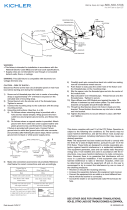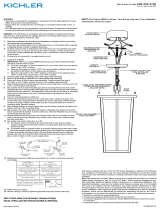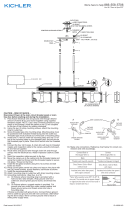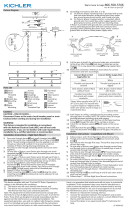Kichler Lighting 44160CLPLED Manuel utilisateur
- Taper
- Manuel utilisateur

Date Issued: 09/25/17 IS-44160LED-CB
We’re here to help 866-558-5706
Hrs: M-F 9am to 5pm EST
CAUTION – RISK OF SHOCK –
Disconnect Power at the main circuit breaker panel or main
fusebox before starting and during the installation.
WARNING:
This xture is intended for installation in accordance with the
National Electrical Code (NEC) and all local code specications.
If you are not familiar with code requirements, installation by a
certied electrician is recommended.
FCC INFORMATION:
This device complies with part 15 of the FCC Rules. Operation is
subject to the following two conditions:
(1) This device may not cause harmful interference, and
(2) this device must accept any interference received, including
interference that may cause undesired operation.
Note: This equipment has been tested and found to comply with the
limits for a Class B digital device, pursuant to part 15 of the FCC
Rules. These limits are designed to provide
reasonable protection against harmful interference in a residential
installation. This equipment generates, uses and can
radiate radio frequency energy and, if not installed and used
in accordance with the instructions, may cause harmful
interference to radio communications. However, there is no
guarantee that interference will not occur in a particular installation.
If this equipment does cause harmful interference
to radio or television reception, which can be determined by
turning the equipment off and on, the user is encouraged to
try to correct the interference by one or more of the following mea-
sures:
• Reorient or relocate the receiving antenna.
• Increase the separation between the equipment and receiver.
• Connect the equipment into an outlet on a circuit different from
that to which the receiver is connected.
• Consult the dealer or an experienced radio/TV technician for help.
Instructions
1) Pass electrical and ground wire through the desired amount of
stems[1], chain links[2], and loops[3] and screw together with
supplied nipples[4].
2) Using the two (2) strap mounting screws[5], attach the mount-
ing strap to the outlet box.
3) Screw threaded pipe into mounting strap. Mounting strap must
be positioned with extruded thread facing into the outlet box.
Threaded pipe must protrude out of the back of the mounting
strap.
4) Install one (1) hexnut under the mounting strap and one (1)
on top of the mounting strap on the threaded pipe; this will
secure the threaded pipe in place. Place third hexnut onto the
threaded pipe.
5) Connect four (4) loops, two (2) chain links with four (4) thread-
ed nipples and inspection cable[6] to the canopy [7].
6) Install 6 glass plates[8] using the (24) washers[9] and (24)
knobs [10] as shown.
7) Screw on the glass mounting plate[11] with (12) screws.
8) Place glass assembly into place utilizing the four(4) hooks[12]
and connecting to the xture[13].
9) Grounding instructions: (See Illus. A or B).
A) On xtures where mounting strap is provided with a hole
and two raised dimples. Wrap ground wire from outlet box
around green ground screw, and thread into hole.
B) On xtures where a cupped washer is provided. Attach
ground wire from outlet box under cupped washer and
green ground screw, and thread into mounting strap.
If xture is provided with ground wire. Connect xture ground
wire to outlet box ground wire with wire connector. (Not pro-
vided.) After following the above steps. Never connect ground
wire to black or white power supply wires.
GREEN GROUND
SCREW
CUPPED
WASHER
OUTLET BOX
GROUND
FIXTURE
GROUND
DIMPLES
WIRE CONNECTOR
OUTLET BOX
GROUND
GREEN GROUND
SCREW
FIXTURE
GROUND
A
B
Connect Black or
Red Supply Wire to:
Connect
White Supply Wire to:
Black White
*Parallel cord (round & smooth) *Parallel cord (square & ridged)
Clear, Brown, Gold or Black
without tracer
Clear, Brown, Gold or Black
with tracer
Insulated wire (other than green)
with copper conductor
Insulated wire (other than green)
with silver conductor
*Note: When parallel wires (SPT I & SPT II)
are used. The neutral wire is square shaped
or ridged and the other wire will be round in
shape or smooth (see illus.)
Neutral Wire
1
2
3
4
5
6
7
9
10
8
11
12
13
10) Make wire connections (connectors not provided.) Reference
chart below for correct connections and wire accordingly.

Date Issued: 09/25/17 IS-44160LED-CB
INSTRUCTIONS
For Assembling and Installing Fixtures in Canada
Pour L’assemblage et L’installation Au Canada
Nous sommes là pour vous aider 866-558-5706
Heures : du lundi au vendredi, de 9h à 17h (heure de l’Est)
ATTENTION – RISQUE DE DÉCHARGES ÉLECTRIQUES -
Couper le courant au niveau du panneau du disjoncteur du
circuit principal ou de la boîte à fusibles principale avant de
procéder à l’installation.
AVERTISSEMENT: Ce luminaire doit être installé conformé-
ment aux codes d’électricité nationaux (NEC) et satisfaire
toutes les spécifications des codes locaux. Si vous ne con-
naissez pas les exigences de ces codes, il est recommandé de
confier l’installation à un électricien certifié.
Cet appareil est conforme à la section 15 de la réglementation de
la FCC. L’exploitation est soumise aux deux conditions suivantes :
(1) Cet équipement ne doit pas causer d’interférences nuisibles, et
(2) cet équipement doit accepter toute interférence reçue, y compris
les interférences risquant d’engendrer un fonctionnement indésir-
able.
Remarque: Des tests ont confirmé que ce matériel respecte les lim-
ites d’un dispositif numérique de catégorie B, en vertu de la section
15 de la réglementation de la FCC. Ces limites ont été conçues
pour fournir une protection raisonnable contre le brouillage nuis-
ible d’une installation résidentielle. Cet équipement génère, utilise
et peut rayonner de l’énergie radiofréquence et, s’il n’est pas in-
stallé et utilisé selon les instructions, peut causer de l’interférence
nuisible aux communications de radio. Cependant, il est néanmoins
possible qu’il y ait de l’interférence dans une installation en particu-
lier. Si cet équipement cause du brouillage nuisible à la réception
du signal de radio ou de télévision, ce qui peut être déterminé en
éteignant puis en rallumant l’appareil, l’usager peut essayer de cor-
riger l’interférence en appliquant une des mesures suivantes :
• Réorienter l’antenne de réception ou changer son emplacement.
• Augmenter la distance séparant l’équipement et le récepteur.
• Brancher le matériel dans la prise de courant d’un circuit différent
de celui auquel le récepteur est branché.
• Consulter le revendeur ou un technicien radio/télé d’expérience.
1) Passez le l électrique et le l de terre à travers la quantité
souhaitée de tiges [1], les maillons de chaîne [2] et les boucles
[3] et visser ensemble avec les tétons fournis [4].
2) En utilisant les deux (2) vis de xation de la sangle [5], xez la
sangle de montage à la boîte de sortie.
3) Vissez le tuyau leté dans la sangle de montage. La sangle de
montage doit être positionnée avec un l extrudé vers le haut
dans la boîte de sortie. Le tuyau leté doit dépasser le dos de
la sangle de montage.
4) Installer un (1) hexagone sous la sangle de montage et un
(1) sur le dessus de la sangle de montage sur le tuyau leté;
Cela permettra de sécuriser le tuyau leté en place. Placez le
troisième écrou hexagonal sur le tuyau leté.
5) Connectez quatre (4) boucles, deux (2) maillons de chaîne
avec quatre (4) raccords letés et le câble d’inspection [6] au
toit [7].
6) Installer 6 plaques de verre [8] en utilisant les (24) rondelles
[9] et (24) les boutons [10] comme indiqué.
7) Vissez la plaque de montage en verre [11] avec (12) vis.
8) Placez l’ensemble en verre en place en utilisant les quatre (4)
crochets [12] et se connectant à l’appareil [13].
9) Connecter les ls. Se porter au tableau ci-dessous pour faire les
connexions.
Connecter le fil noir ou
rouge de la boite
Connecter le fil blanc de la boîte
A Noir A Blanc
*Au cordon parallèle (rond et lisse)
*Au cordon parallele (à angles droits el strié)
Au bransparent, doré, marron, ou
noir sans fil distinctif
Au transparent, doré, marron, ou
noir avec un til distinctif
Fil isolé (sauf fil vert) avec
conducteur en cuivre
Fil isolé (sauf fil vert) avec
conducteur en argent
*Remarque: Avec emploi d’un fil paralléle
(SPT I et SPT II). Le fil neutre est á angles
droits ou strié et l’autre fil doit étre rond ou
lisse (Voir le schéma).
Fil Neutre
1
2
3
4
5
6
7
9
10
8
11
12
13
-
 1
1
-
 2
2
Kichler Lighting 44160CLPLED Manuel utilisateur
- Taper
- Manuel utilisateur
dans d''autres langues
Documents connexes
-
 Kichler Lighting 10630PNLED Manuel utilisateur
Kichler Lighting 10630PNLED Manuel utilisateur
-
Kichler 10797NILED Manuel utilisateur
-
 Kichler Lighting 49626BKTLED Manuel utilisateur
Kichler Lighting 49626BKTLED Manuel utilisateur
-
 Kichler Lighting 11305NILED Manuel utilisateur
Kichler Lighting 11305NILED Manuel utilisateur
-
 Kichler Lighting 11252NILED Manuel utilisateur
Kichler Lighting 11252NILED Manuel utilisateur
-
 Kichler Lighting 11314NILED Manuel utilisateur
Kichler Lighting 11314NILED Manuel utilisateur
-
 Kichler Lighting 43896OZ Manuel utilisateur
Kichler Lighting 43896OZ Manuel utilisateur
-
 Kichler Lighting 44344WNWLED Manuel utilisateur
Kichler Lighting 44344WNWLED Manuel utilisateur
-
 Kichler Lighting 42497NI Manuel utilisateur
Kichler Lighting 42497NI Manuel utilisateur









